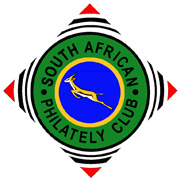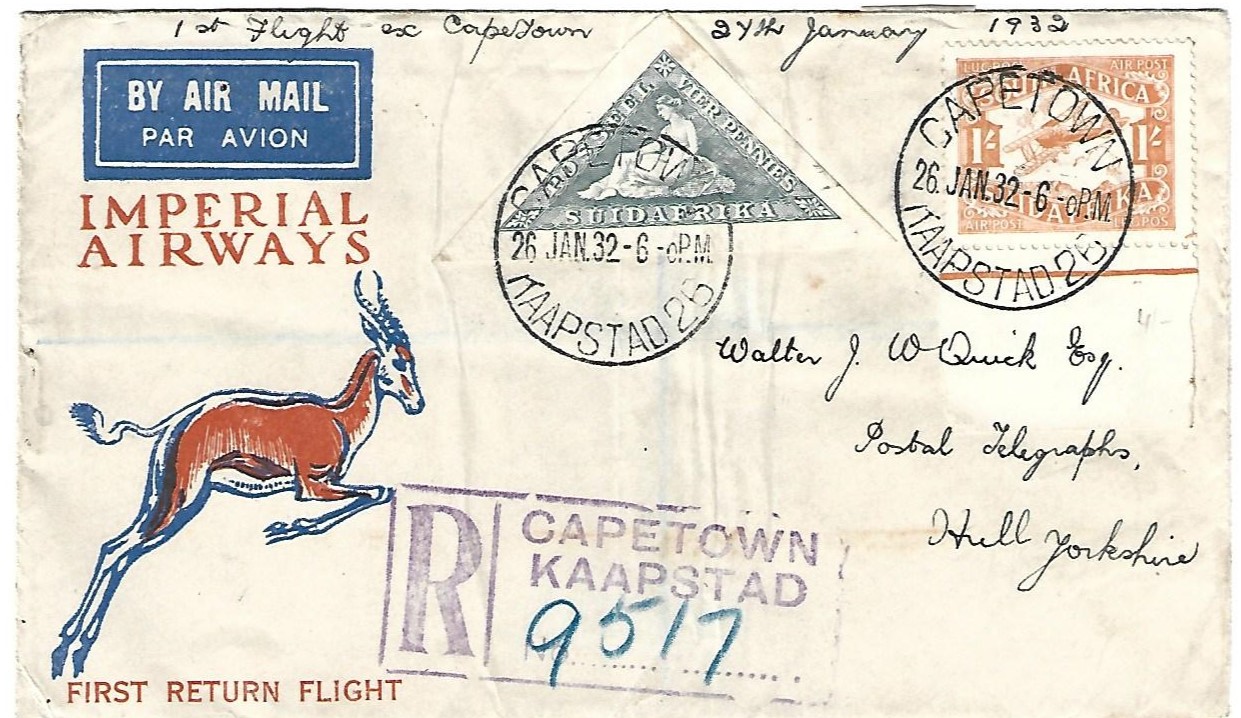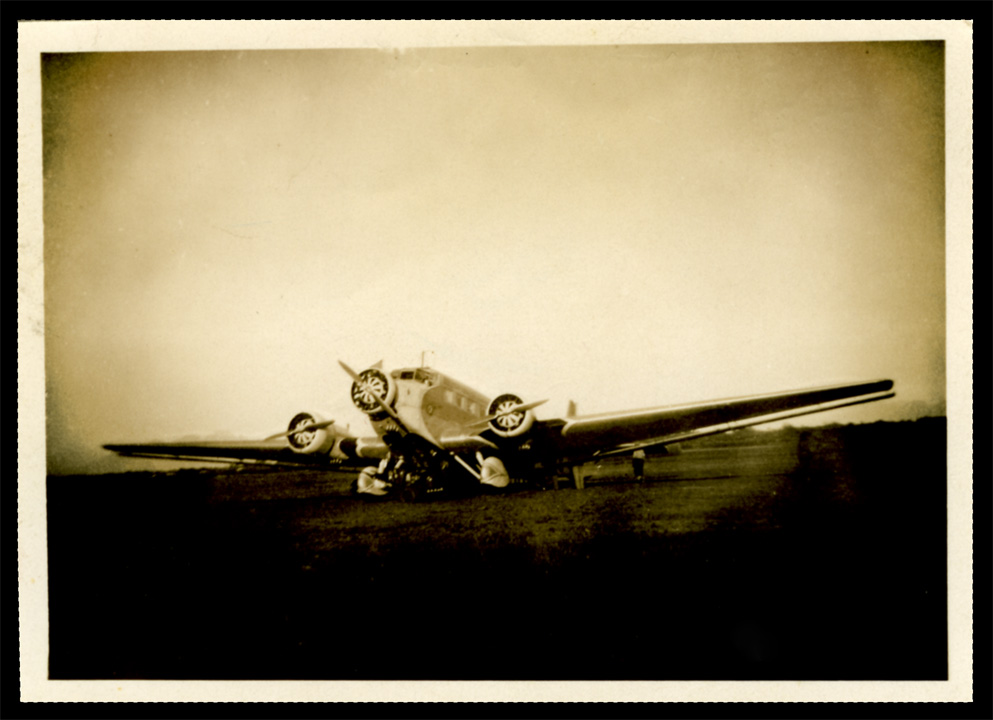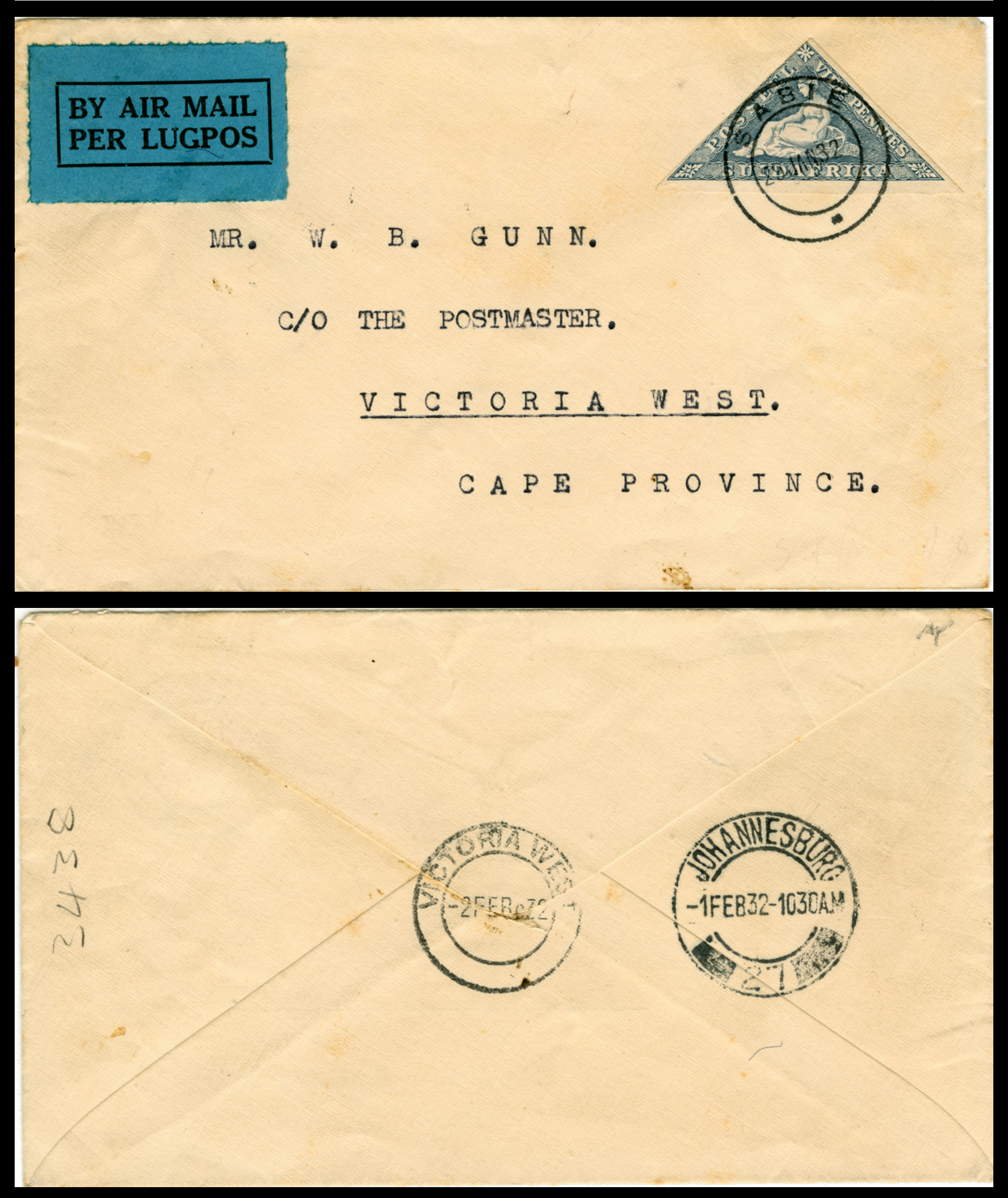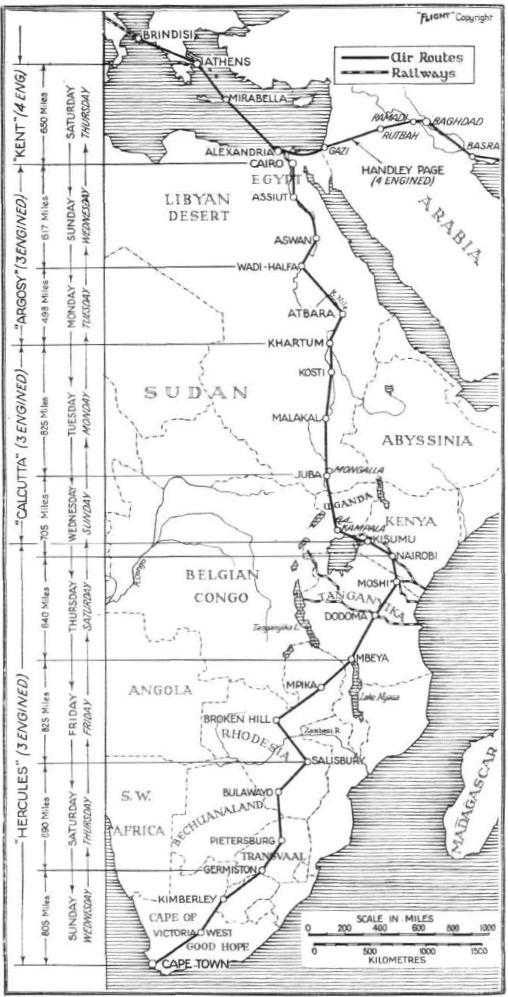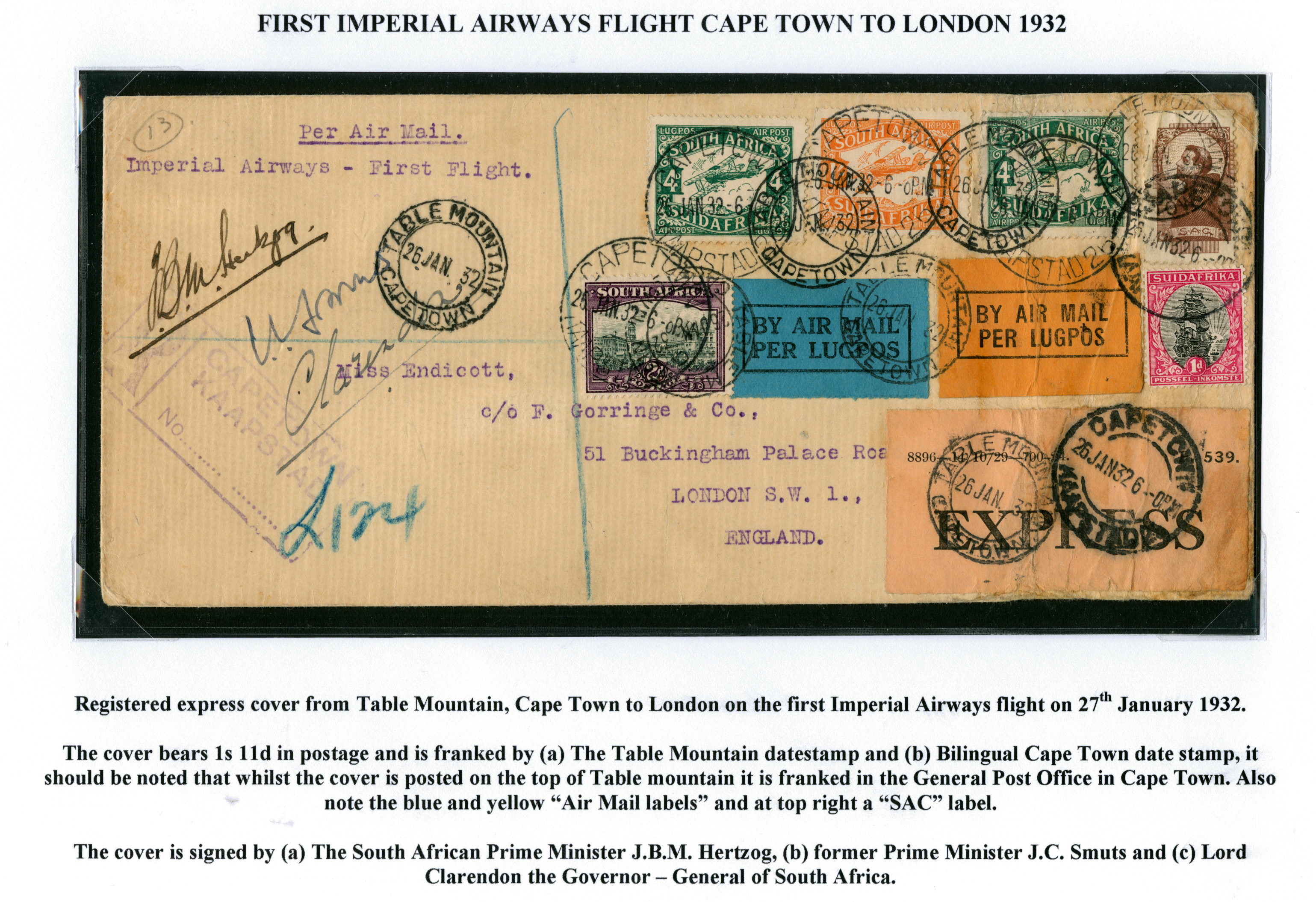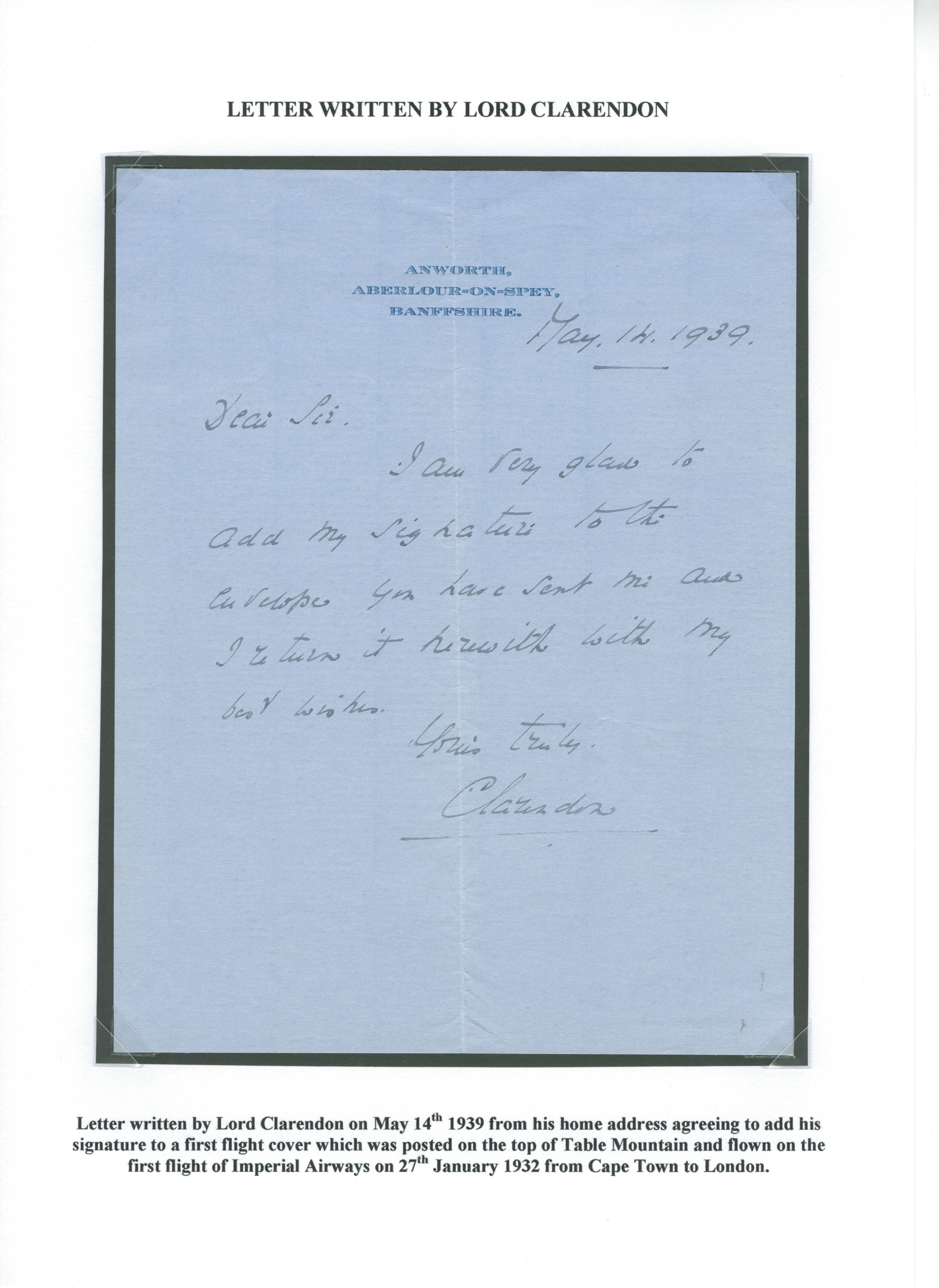Airmail First Flight Covers
Quote from Andrew Massyn on February 11, 2023, 8:33 amI have also been keeping an eye out for these, and recently got the cover below. The Registration number is 9517. It arrived in Hull on 16th February 1932.
I think it should be borne in mind that the Second Air Service was inaugurated by the Government on 16th August 1929. From my reading, Imperial Airways was a subsidised British carrier which was subsidised, to the detriment of the colonies, in particular South Africa and India.
An article here: https://www.persee.fr/doc/rbph_0035-0818_2000_num_78_3_4469 mentions that
"The other branch to Imperial Airways' Empire network extended south from its Cairo hub across eastern Africa to Cape Town and, as with its Asian route it faced problems not only with hazardous conditions but also political obstacles born out of nationalist protectionism. The route had been developed in the mid- 1920s by the RAF and also by Sir Alan Cobham, whose airline Imperial bought in 1931. The colonial governments in Uganda, Kenya, Tanganyika and Northern Rhodesia built the necessary airstrips with some help from the British taxpayer, and in 1932 a regular air mail and passenger service was begun. However in 1934 the Afrikaner government refused to renew Imperial's airmail contract and demanded that it terminate its service in Southern Rhodesia, whence South African Airways would carry the mail to the Cape.
---
See also: Struggle for prominence: Clashing Dutch and British Interests on the Colonial Air Routs 1918 - 1942
Journal of Contemporary History, Vol. 26, No. 2 (Apr., 1991), pp. 333-351 (19 pages)
I have also been keeping an eye out for these, and recently got the cover below. The Registration number is 9517. It arrived in Hull on 16th February 1932.
I think it should be borne in mind that the Second Air Service was inaugurated by the Government on 16th August 1929. From my reading, Imperial Airways was a subsidised British carrier which was subsidised, to the detriment of the colonies, in particular South Africa and India.
An article here: https://www.persee.fr/doc/rbph_0035-0818_2000_num_78_3_4469 mentions that
"The other branch to Imperial Airways' Empire network extended south from its Cairo hub across eastern Africa to Cape Town and, as with its Asian route it faced problems not only with hazardous conditions but also political obstacles born out of nationalist protectionism. The route had been developed in the mid- 1920s by the RAF and also by Sir Alan Cobham, whose airline Imperial bought in 1931. The colonial governments in Uganda, Kenya, Tanganyika and Northern Rhodesia built the necessary airstrips with some help from the British taxpayer, and in 1932 a regular air mail and passenger service was begun. However in 1934 the Afrikaner government refused to renew Imperial's airmail contract and demanded that it terminate its service in Southern Rhodesia, whence South African Airways would carry the mail to the Cape.
---
See also: Struggle for prominence: Clashing Dutch and British Interests on the Colonial Air Routs 1918 - 1942
Quote from Andrew Massyn on February 11, 2023, 8:37 amAnd just a point of interest. What happened to the aircraft? From the Wikipedia article.
de Havilland Hercules 9 1926–35 City of Cairo (wrecked 1931), City of Delhi (to SAAF 1934), City of Baghdad (withdrawn 1933), City of Jerusalem, City of Tehran, City of Basra (to SAAF 1934), City of Karachi (withdrawn 1935), City of Jodhpur (sold) and City of Cape Town (sold)[42]
And just a point of interest. What happened to the aircraft? From the Wikipedia article.
| de Havilland Hercules | 9 | 1926–35 | City of Cairo (wrecked 1931), City of Delhi (to SAAF 1934), City of Baghdad (withdrawn 1933), City of Jerusalem, City of Tehran, City of Basra (to SAAF 1934), City of Karachi (withdrawn 1935), City of Jodhpur (sold) and City of Cape Town (sold)[42] |
Quote from Steve on February 11, 2023, 11:04 amThank you for not shying away from the influence of politics on Imperial and colonial airmail services. As an arm of government, the Post Office should not be immune from political comment. State intervention back then was as politically motivated as it is today. During this time in SA, (1932), Afrikaner sympathy for Hitler's resurgent Nazis following Germany's defeat in WW1 was germinating. The Hertzog government's deep aversion to British imperialism would lead to it buying airliners from Nazi Germany, not Britain. I cannot fault the Herzog government for standing up to British imperialism but I do take issue with them acting largely only in interests of Afrikaners rather than all of SA's people. But, of course, that was the time and place we all came from, our collective history. See the Junkers 52 snapshot below which I bought at a UK carboot sale. It has 'South Africa' written on the reverse. No date.
Second, I do not really collect airmails. In the good old days of Saturday stamping I largely bought what attracted me - eye candy! This has resulted in a huge accumulation, not a focussed area of deep study. Out of that has come this somewhat inadequate conversation. I wish I could contribute better advice. I cannot. I am a dilettante who has built a half-baked website where, quite remarkaby, your cover shown above (Registered Letter 9517 of '26 JAN 32') follows on from mine (Registered Letter 9516 of 26 JAN 32'). I am tempted to say "what are the chances of that?" but because we both collect this area - you more than me - and because there is not a mass of material from the first flight, such a remarkable coincidence was always possible, especially on the internet. Still, I am amazed that two consecutive Registered Letter items from over 90 years ago can be linked together across time and space today! It shows what we can achieve if like-minded collectors come together to discuss, show and share their material with each other.
Third, I wish that I could get people in who are really enthusiastic and knowledgeable about airmails to help answer your questions. I am not that guy, nor am I that girl despite whatever kids are being taught at school today!
Fourth, in 1932 the time taken to get an airmail letter from Cape Town to GB was approximately as long as surface mail by ship. Given that your airmail letter above cost 1/- 4d compared to 2d surface mail, you needed a disposable income to justify using airmail! In 1932 my father was 16 years old in Hull, starting his first job at 5/- a week. Any thought of using airmail was a waste of time and money! (Incidentally, in August 1921 on a warm later summer evening my five-year old father was among thousands of people observing the curious sight of an airship, the R.38. He saw it make a sharp turn at speed (!), break in two in mid-flight and explode, falling into the wide gray waters of the river Humber. An official enquiry concluded that the airframe had failed under extreme control forces.)
Fifth, I imagine the aircraft were scrapped. It's what they did back then. Aircraft were developing so rapidly that anything older than a few years soon became obsolete. Back then, there was no good reason to keep antiquated biplanes. When I was a boy there was scrapyard in Maitland, Cape Town, called Crash Flash where you went to find spare car parts. Mounted on a pole close to the Voortrekker Road entrance was a rare surviving Hawker Hurricane fighter airframe. Such an historic treasure would be worth a fortune today but back then there was no interest in it.
Thank you for not shying away from the influence of politics on Imperial and colonial airmail services. As an arm of government, the Post Office should not be immune from political comment. State intervention back then was as politically motivated as it is today. During this time in SA, (1932), Afrikaner sympathy for Hitler's resurgent Nazis following Germany's defeat in WW1 was germinating. The Hertzog government's deep aversion to British imperialism would lead to it buying airliners from Nazi Germany, not Britain. I cannot fault the Herzog government for standing up to British imperialism but I do take issue with them acting largely only in interests of Afrikaners rather than all of SA's people. But, of course, that was the time and place we all came from, our collective history. See the Junkers 52 snapshot below which I bought at a UK carboot sale. It has 'South Africa' written on the reverse. No date.
Second, I do not really collect airmails. In the good old days of Saturday stamping I largely bought what attracted me - eye candy! This has resulted in a huge accumulation, not a focussed area of deep study. Out of that has come this somewhat inadequate conversation. I wish I could contribute better advice. I cannot. I am a dilettante who has built a half-baked website where, quite remarkaby, your cover shown above (Registered Letter 9517 of '26 JAN 32') follows on from mine (Registered Letter 9516 of 26 JAN 32'). I am tempted to say "what are the chances of that?" but because we both collect this area - you more than me - and because there is not a mass of material from the first flight, such a remarkable coincidence was always possible, especially on the internet. Still, I am amazed that two consecutive Registered Letter items from over 90 years ago can be linked together across time and space today! It shows what we can achieve if like-minded collectors come together to discuss, show and share their material with each other.
Third, I wish that I could get people in who are really enthusiastic and knowledgeable about airmails to help answer your questions. I am not that guy, nor am I that girl despite whatever kids are being taught at school today!
Fourth, in 1932 the time taken to get an airmail letter from Cape Town to GB was approximately as long as surface mail by ship. Given that your airmail letter above cost 1/- 4d compared to 2d surface mail, you needed a disposable income to justify using airmail! In 1932 my father was 16 years old in Hull, starting his first job at 5/- a week. Any thought of using airmail was a waste of time and money! (Incidentally, in August 1921 on a warm later summer evening my five-year old father was among thousands of people observing the curious sight of an airship, the R.38. He saw it make a sharp turn at speed (!), break in two in mid-flight and explode, falling into the wide gray waters of the river Humber. An official enquiry concluded that the airframe had failed under extreme control forces.)
Fifth, I imagine the aircraft were scrapped. It's what they did back then. Aircraft were developing so rapidly that anything older than a few years soon became obsolete. Back then, there was no good reason to keep antiquated biplanes. When I was a boy there was scrapyard in Maitland, Cape Town, called Crash Flash where you went to find spare car parts. Mounted on a pole close to the Voortrekker Road entrance was a rare surviving Hawker Hurricane fighter airframe. Such an historic treasure would be worth a fortune today but back then there was no interest in it.
Uploaded files:Quote from Steve on February 11, 2023, 5:32 pmAnyone wanting a top-class, informative and visually pleasing introduction to South Africa's first airmails (and airplanes) should take a close look at Danie van Zyl's display on this site.
See: https://southafricanphilatelyclub.com/3d-flip-book/airplanes-airmail-in-south-africa
Anyone wanting a top-class, informative and visually pleasing introduction to South Africa's first airmails (and airplanes) should take a close look at Danie van Zyl's display on this site.
See: https://southafricanphilatelyclub.com/3d-flip-book/airplanes-airmail-in-south-africa
Quote from Steve on April 10, 2023, 10:04 amI bought this from a dealer for someone who is starting a Kruger Park display. I realise that this is not a classic first flight item but I am hoping that some of you will know more about this than me.
The cover has the 1926 Union 4d triangle and an early-ish blue 'BY AIRMAIL PER LUGPOS' label. It is a domestic airmail cover that no doubt follows a documented route. I am not sure of the route flown, probably not from SABIE, almost certainly from JOHANNESBURG '1 FEB 32' direct to VICTORIA WEST '2 FEB 32'. Both are good postmark strikes. Was this part of a first flight? I'm guessing not. Is there anything of particular interest about this cover?
The interest for my young SACS colleague lies in the neat and complete SABIE postmark of '29 JAN 32'. I image this went from Sabie by road to Johannesburg from where it went via airmail to Victoria West. It tells us that the Postmaster in Victoria West in February 1932 was Mr W B Gunn. Is there anything else she should know?
Postscript
My mistake. Sabie is located 360 kilometres east of Johannesburg and 64 kilometres west of the popular Kruger National Park ie. it is not in the Kruger Park. I confused it with Lower Sabie Rest Camp which is on the banks of the Sabie River.
I bought this from a dealer for someone who is starting a Kruger Park display. I realise that this is not a classic first flight item but I am hoping that some of you will know more about this than me.
The cover has the 1926 Union 4d triangle and an early-ish blue 'BY AIRMAIL PER LUGPOS' label. It is a domestic airmail cover that no doubt follows a documented route. I am not sure of the route flown, probably not from SABIE, almost certainly from JOHANNESBURG '1 FEB 32' direct to VICTORIA WEST '2 FEB 32'. Both are good postmark strikes. Was this part of a first flight? I'm guessing not. Is there anything of particular interest about this cover?
The interest for my young SACS colleague lies in the neat and complete SABIE postmark of '29 JAN 32'. I image this went from Sabie by road to Johannesburg from where it went via airmail to Victoria West. It tells us that the Postmaster in Victoria West in February 1932 was Mr W B Gunn. Is there anything else she should know?
Postscript
My mistake. Sabie is located 360 kilometres east of Johannesburg and 64 kilometres west of the popular Kruger National Park ie. it is not in the Kruger Park. I confused it with Lower Sabie Rest Camp which is on the banks of the Sabie River.
Quote from Andrew Massyn on April 12, 2023, 2:11 pmThe first flight that I can find was from Cape Town to Victoria West on 26th January 1932, arriving 27th January, see here: https://www.filat.ch/Aerophilately/South-Africa/SOUTH-AFRICA-1932-PILOT-SIGNED-FIRST-FLIGHT-TO-VICTORIA-WEST
The first flight from Victoria West would in all likelihood have been on 27th January 932. There are several covers available with a date mark of 27th January from Victoria West with a transit stamp showing the plane landed in Johannesburg on the same day.
I can't find the first " return flight", but I assume this would have been the Imperial flight from London to Cape Town. The earliest Johannesburg to Cape Town flight seems to have been via Durban on 03 January 1933 and from Durban to Cape Town arriving on the 08th January.
Here is a copy of the Imperial Airways Route.
The first flight that I can find was from Cape Town to Victoria West on 26th January 1932, arriving 27th January, see here: https://www.filat.ch/Aerophilately/South-Africa/SOUTH-AFRICA-1932-PILOT-SIGNED-FIRST-FLIGHT-TO-VICTORIA-WEST
The first flight from Victoria West would in all likelihood have been on 27th January 932. There are several covers available with a date mark of 27th January from Victoria West with a transit stamp showing the plane landed in Johannesburg on the same day.
I can't find the first " return flight", but I assume this would have been the Imperial flight from London to Cape Town. The earliest Johannesburg to Cape Town flight seems to have been via Durban on 03 January 1933 and from Durban to Cape Town arriving on the 08th January.
Here is a copy of the Imperial Airways Route.
Uploaded files:Quote from Steve on April 12, 2023, 4:00 pmThank you for looking into this and replying, Andrew, and also posting the route map.
Your reply has left me none the wiser and somewhat rudely plucked from my previous happy notion that the cover was transported by air from JOHANNESBURG '1 FEB 32' direct to VICTORIA WEST '2 FEB 32'. You are suggesting that is now not be the case. So, I am wondering what happened? Could this have gone down on the second flight from Johannesburg to Cape Town, about a week later? I believe it was flown - but how and when?
Thank you for looking into this and replying, Andrew, and also posting the route map.
Your reply has left me none the wiser and somewhat rudely plucked from my previous happy notion that the cover was transported by air from JOHANNESBURG '1 FEB 32' direct to VICTORIA WEST '2 FEB 32'. You are suggesting that is now not be the case. So, I am wondering what happened? Could this have gone down on the second flight from Johannesburg to Cape Town, about a week later? I believe it was flown - but how and when?
Quote from Andrew Massyn on April 13, 2023, 7:01 amSorry, After I posted, I found that the first Flight from the UK to South Africa on the Imperial Airways was actually on the 20th January from Croydon to SA, see here: https://www.thisdayinaviation.com/20-january-1932/ ; so if we give that flight 10 days or so to get to Johannesburg, it would have then left for Cape town on or about the 01 February which would fit in with your cover. I hadn't traced the route for that specific flight so did not include it.
Sorry, After I posted, I found that the first Flight from the UK to South Africa on the Imperial Airways was actually on the 20th January from Croydon to SA, see here: https://www.thisdayinaviation.com/20-january-1932/ ; so if we give that flight 10 days or so to get to Johannesburg, it would have then left for Cape town on or about the 01 February which would fit in with your cover. I hadn't traced the route for that specific flight so did not include it.
Quote from Steve on April 13, 2023, 7:51 amThank you, Andrew. That is good news and more-or-less what I was hoping to hear. However, as I have now learned that Sabie is a town outside of the Kruger Park, my young colleague will be disappointed to know that this cover is from a short section of an Imperial Airways First Flight and is not relevant to her Kruger Park collection.
Thank you, Andrew. That is good news and more-or-less what I was hoping to hear. However, as I have now learned that Sabie is a town outside of the Kruger Park, my young colleague will be disappointed to know that this cover is from a short section of an Imperial Airways First Flight and is not relevant to her Kruger Park collection.
Quote from Underbidder on May 17, 2023, 12:03 pmI have been wanting to add to the conversation on this website for some time but with Covid, moving home, not being technical and not getting to the library as often as I would like, I have not been able to join in. Things have now improved to the point that I hope to be able to contribute more often. I thought I would start with this First Flight cover. While I do collect Apartheid, Cape, Maritime Mail and Table Mountain, etc., I generally do not collect Airmail covers. This is from my Table Mountain display. There is a story behind the signatures. Lord Clarendon's note shows that he added his signature to the letter in 1939. The 'SAC' cinderella top right is from a Catholic organisation.
Keep up the good work, Steve.
I have been wanting to add to the conversation on this website for some time but with Covid, moving home, not being technical and not getting to the library as often as I would like, I have not been able to join in. Things have now improved to the point that I hope to be able to contribute more often. I thought I would start with this First Flight cover. While I do collect Apartheid, Cape, Maritime Mail and Table Mountain, etc., I generally do not collect Airmail covers. This is from my Table Mountain display. There is a story behind the signatures. Lord Clarendon's note shows that he added his signature to the letter in 1939. The 'SAC' cinderella top right is from a Catholic organisation.
Keep up the good work, Steve.
Uploaded files: